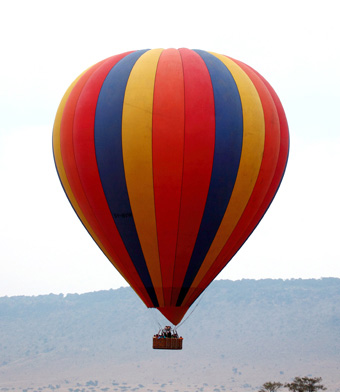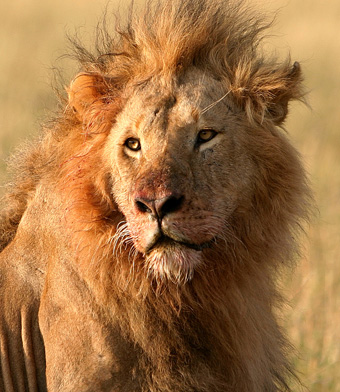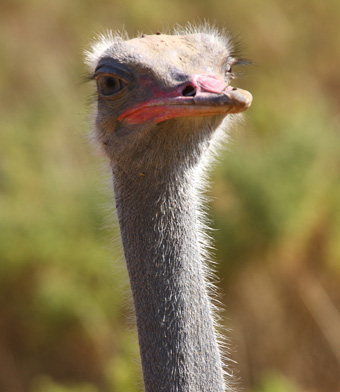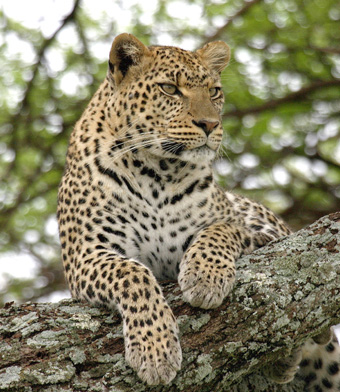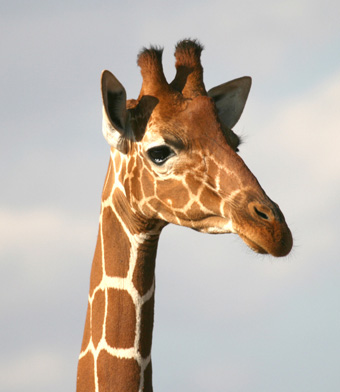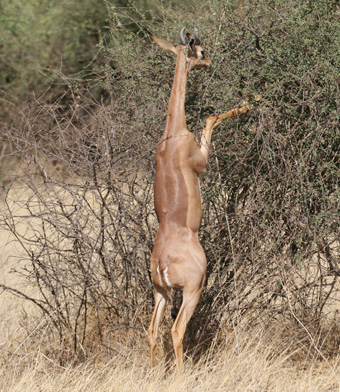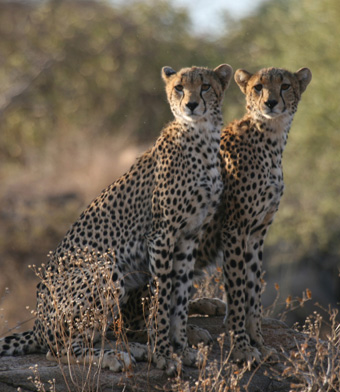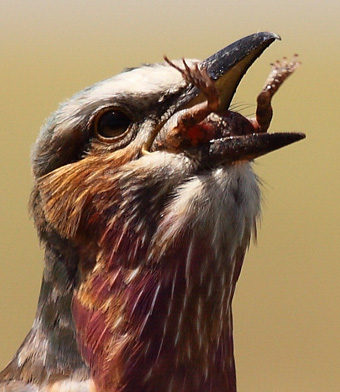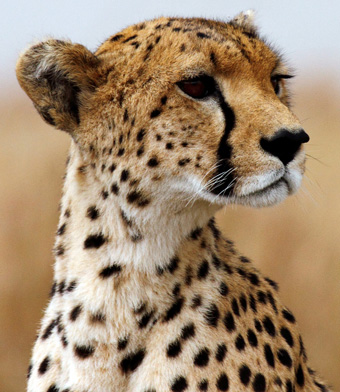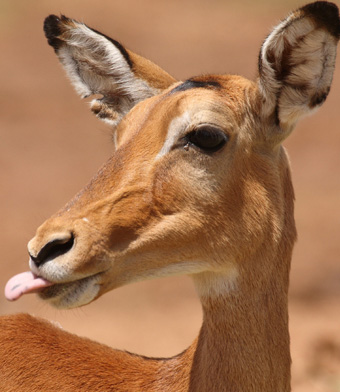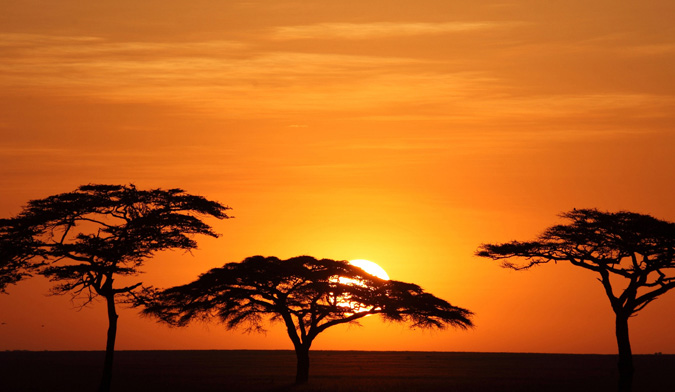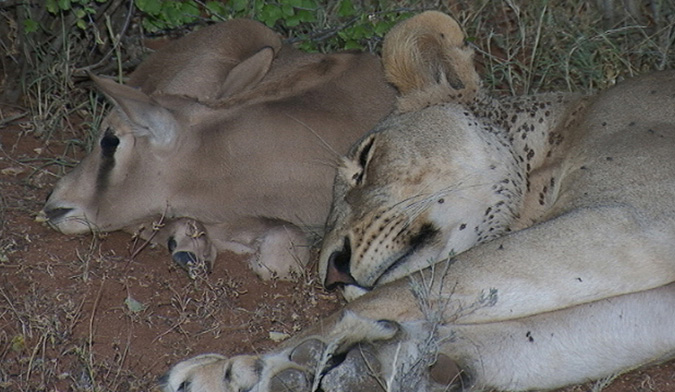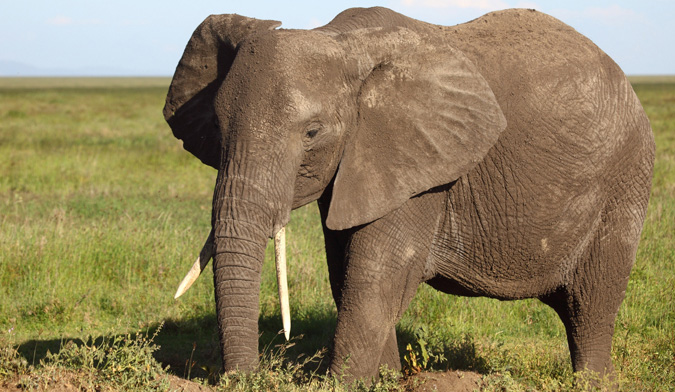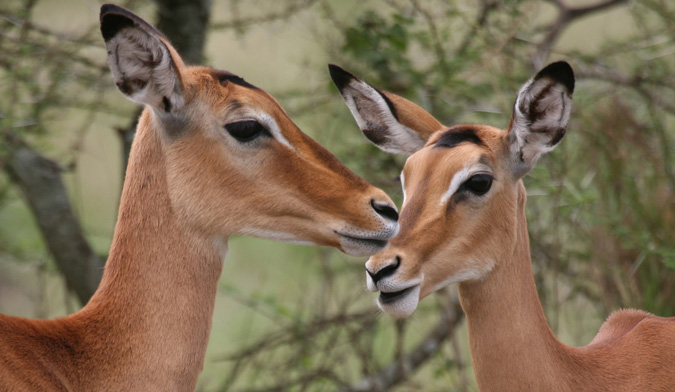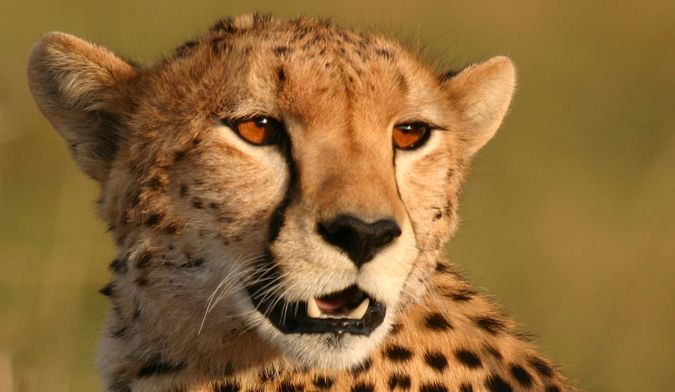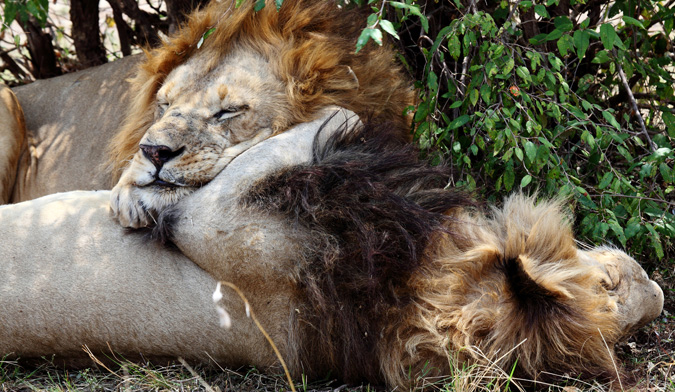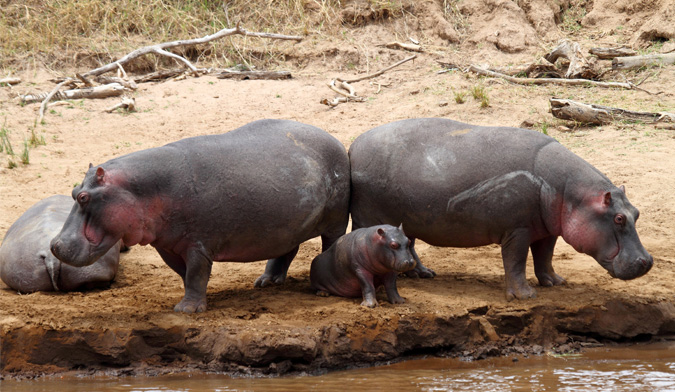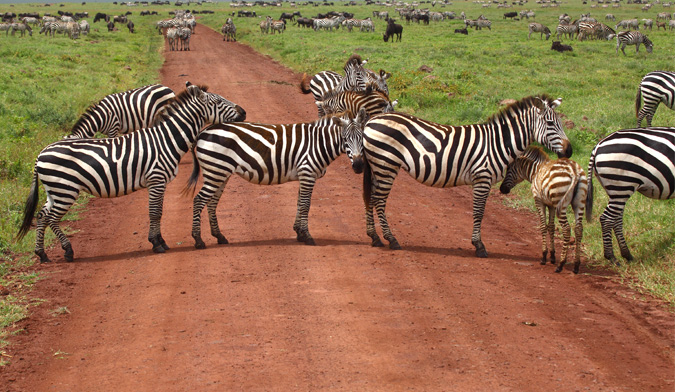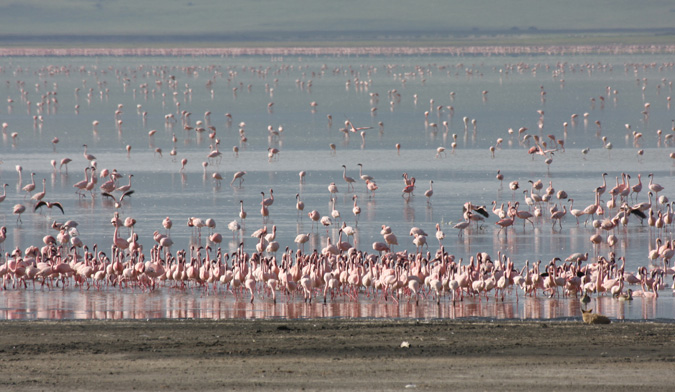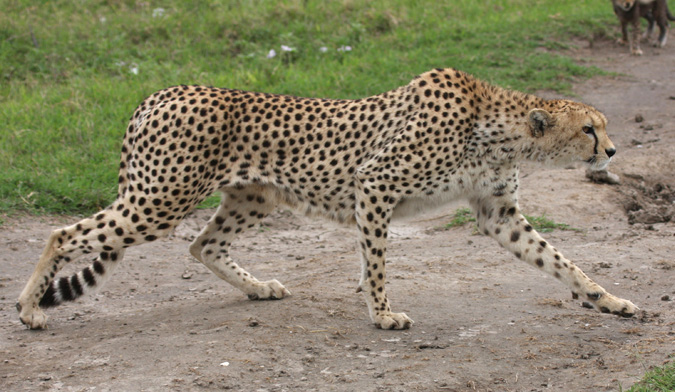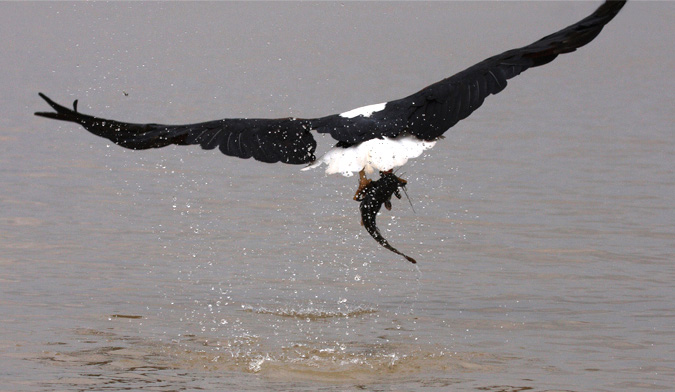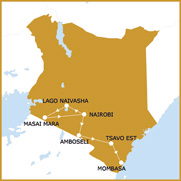 |
duration 6 nights – 6 1.2 days point of departure city hotels itinerary code RT163 day of departure tuesdays transport landcruiser 4x4 |
|
- itinerary
- tariff
- lodges
- parks
Day 1 Nairobi – Maasai Mara Reserve - 280 km /5h30 approximately
Drive to the Masai Mara. Lunch followed by an afternoon game drive. Dinner and overnight stay at Mara Sopa lodge FB.
Day 2 Maasai Mara Reserve
Full day in the Masai Mara with morning and afternoon game drives. Dinner and overnight stay at Mara Sopa lodge FB.
Day 3 Maasai Mara Reserve/Lake Naivasha - 240 km / 4h30 approximately
Leave the Masai Mara and drive to Lake Naivasha. Lunch followed by a boat trip on the Lake. Chance to spot the resident hippo and prolific bird life around the lakeshore.Dinner and overnight stay at Lake Naivasha Sopa lodge FB .
Day 4 Lake Naivasha / Nairobi / Amboseli - 90 km / 2h30 approximately + 260 km / 5h approximately
Today the safari continues to Amboseli with lunch on route at Nairobi’s famous Carnivore Restaurant. We arrive in Amboseli late afternoon. Dinner and overnight stay at Amboseli Sopa lodge HB
Day 5 Amboseli
Morning and afternoon game drives in Amboseli. Dinner and overnight stay at Amboseli Sopa Lodge FB.
Day 6 Amboseli / Ngutuni Sanctuary - 320 km / 6h approximately
Leave Amboseli and drive to Kilaguni Lodge. Lunch followed by an afternoon game drive in Tsavo West. Continue to Ngutuni Sanctuary. Dinner and overnight stay at Ngutuni Lodge FB.
Day 7 Ngutuni Sanctuary / Mombasa - 175 km / 2h30 approximately
After breakfast a short game drive. Continue to Mombasa. Drop off early afternoon at a coast hotel.
Prices quoted are per person and are for the specified itinerary and dates
dal 16 dicembre 2014 al 15 dicembre 2015 Safaris are guaranteed to operate with a minimum of 2 persons from 16/12/2014 to 31/03/2015 and 01/07/2015 to 31/10/2015 with a minimum of 4 persons from 07/04/2015 to 30/06/2015 and from 01/11/2015 to 15/12/2015.
The guarantee to operate is subject to availability of space in the vehicle and in accommodation at the lodges and hotels indicated in the itinerary. The itinerary may operate by reversing the order of the itinerary without changing its quality.
Prices from US$ 1.835 per person in a double room
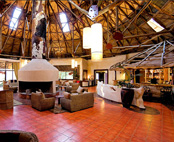 |
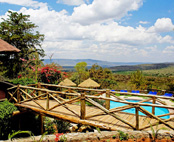 |
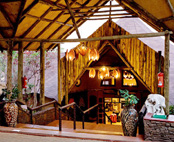 |
Mara Sopa lodge
Located high on the slopes of the Oloolaimutia Hills, Masai Mara Sopa Lodge was one of the first safari lodges to be built in the Maasai Mara Game Reserve, a reason why its gardens and trees are so lush and mature. All the buildings follow the design of traditional African round houses with conical roofs, and these stretch along the line of the hills with the impressively large public area buildings and the swimming pool at their centre.
With its rolling hills, dense riverine forests, hills and a high, flat-topped escarpment that forms its western boundary, this wildlife conservation area takes up an area of 1,510sq.kms in south western Kenya and shares an international border with Tanzania’s fabled Serengeti National Park. It is owned and managed by the Maasai people who, because of their traditional respect for wildlife during the course of hundreds of years of their continued co-existence, they have ensured that the wildlife splendour of the Maasai Mara exists today.
While this reserve is home to over 410 species of birds and 60 species of raptors, it is also one of the world’s finest game viewing destinations. This is because it plays host to an abundance of every form of wildlife possible except for those few species which can only be seen north of the Equator, and from our Samburu Sopa Lodge
Not only this, but the reserve is also world famous for its annual migration of literally millions of wildebeest – not to mention tens of thousands of zebras and gazelles – when they annually migrate north from the Serengeti, usually between July/early August to October, to find food. To access the reserve’s lush grazing they first have to cross the Mara River with its battalions of enormous and hungry crocodiles and, if you are lucky enough to watch one of these crossings, it is an event you will never forget.
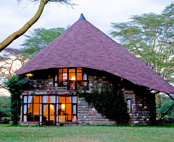 |
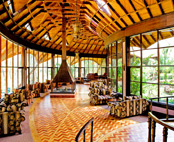 |
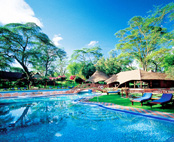 |
Lake Naivasha Sopa lodge
Set in one hundred and fifty acres of grassland studded with Acacia bushes and trees, the resort is not only home to our resident giraffe, waterbuck and both Vervet and Colobus monkeys, but it is also a night stop for the hippos when they leave the lake every night to come and trim the grass on our expansive lawns.
With Sopa’s traditional and conscientious care for the environment, we carefully positioned all the buildings on our property so we did not have to fell any of the many trees there. As a result of this, we had to come up with a radically innovative and artistic design for the main public area building which now snakes its way between the trees with long and graceful curves.
Lake Naivasha is a freshwater lake in the Kenya section of Africa’s Great Rift Valley, and is located north west of Nairobi with the town of Naivasha on its north eastern shore. At 1,890 meters (6,200 ft) above sea level, the lake is at the highest point in the Kenyan rift, and is set in a complex geological combination of volcanic rocks and sedimentary deposits from a much larger Pleistocene era lake. Because the outlet for this ancient lake, now called Njorwa Gorge, is today much higher than the lake, the original Lake Naivasha must have indeed been a truly vast expanse of water. The gorge now forms the entrance to the Hell’s Gate National Park which, for obvious reasons, today contains some spectacular examples of water and weather-worn rock formations as well as an abundance of flora and fauna to include some extremely rare, resident breeding pairs of Lammergeyers, otherwise known as Bearded vultures.
Apart from transient streams, Lake Naivasha is fed by the perennial Malewa and Gilgil rivers and, most unusually, it now has no visible outlet. However, it must be assumed that such a large body of water has to have an underground outflow through a volcanic fissure or similar somewhere beneath the expanse of its lake bed, and it has been suggested that the water emerges through the fresh but hot water springs at Lake Magadi, an otherwise brackish and pinkish coloured soda lake 120kms to the south.
Because this is a volcanic area, as witnessed by Mount Longonot, an extinct nearby volcano to the south east, and ancient fumaroles – including the tiny but spectacular Crater Lake – to the west, Kenya is blessed with the presence of the Olkarria Geothermal electrical generating complex – high in the hills just to the south – which feeds massive amounts of much needed power into the national grid. halls with their four differently sized meeting areas, and our stables are so widely set apart.
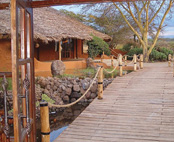 |
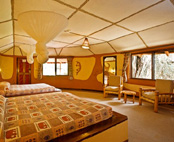 |
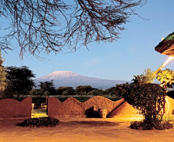 |
Amboseli Sopa lodge
ISet in 200 acres of private land, and with a rustic charm all of its own, the lodge nestles in the foothills of Mount Kilimanjaro which, at almost six thousand metres, is Africa’s highest and most famous snowcapped mountain. It was this region of Kenya that, in the 1930’s, inspired Ernest Hemingway’s unforgettable stories ‘The Snows of Kilimanjaro’ and ‘The Short, Happy Life of Francis Macomber’ which were turned into more than successful feature films in the late 1940’s due to their renowned actors. All forms of wildlife still abound in this wilderness which continues all the way to the Amboseli National Park, an easy twenty minute drive away from the lodge.
While the park conserves over six hundred breeding species of birds as well a host of rare and wonderful wildlife, this is also home to the Maasai people, perhaps the world’s most renowned African tribe.
The Amboseli National Park’s ecosystem is mainly savannah grassland spread across the Kenya-Tanzania border, and also comprises of forested areas around some of its rivers and lakes. The park is famous for being the best place in Africa to get close to free-ranging elephants among other wildlife species, and its other attractions include opportunities to meet the Maasai tribe’s people, and its spectacular views of Mount Kilimanjaro.
With all this and more to see in the park, you might decide to spend a full day there instead of returning to our lodge for lunch. Should this be the case, and for your convenience, we have a tented luncheon and bar venue within a five minute drive from the park gates.
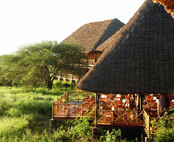 |
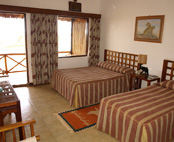 |
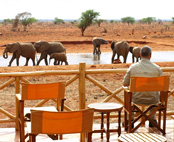 |
Ngutuni Lodge
Ngutuni Lodge is a luxury safari lodge located in the heart of a 10,000 acre private game sanctuary, surrounded on three sides by Tsavo East National Park. The lodge overlooks a water hole and is set against the spectacular backdrop of the Sagala Hills, only 2.5 hours drive from Mombasa and its international airport.
Once home to the infamous 'man eating lions of Tsavo' who preyed on men constructing the railway line between Mombasa and Kampala in the nineteenth century, the sanctuary and surrounding national park are best known today for their fantastic variety of wildlife including lion, cheetah, elephant, buffalo as well as a huge variety of plains game and bird life.
Spectacularly constructed from large timber poles, with plunging thatched roofs and waxed timber decking, the lodge skillfully blends traditional African design with the modern comforts of a luxury lodge. From the moment you step into reception and gaze through the open plan restaurant to the savannah beyond you begin to realise why this is such a special lodge.
Life at Ngutuni follows a delightful routine, early mornings and late afternoons are spent game viewing as this is the best time to observe animals foraging for food in the surrounding savannah. Evenings are spent relaxing with safari companions; time to enjoy a sundowner overlooking the softly illuminated waterhole before a sumptuous dinner. Finally enjoy a few quiet moments under star lit skies as you savour the lights and sounds of the African bush.
Maasai Mara Game Reserve
Maasai Mara is situated in south-west Kenya and is one of Africa’s Greatest Wildlife Reserves. Together with the Serengeti National Park in Tanzania it forms Africa’s most diverse, incredible and most spectacular eco-systems and possibly the world’s top safari big game viewing eco-system. Made famous by the abundance of the big cats, Lion, Leopard, Cheetah and the Great Wildebeest Migration and the Maasai people, well known for their distinctive custom and dress. There is a wide selection of places to stay in and around the Maasai Mara and the conservancies surrounding it . The conservancies surrounding the Maasai Mara have restricted number of vehicles allowing a more private game viewing of wildlife. The Maasai Mara Ecosystem (see our map) holds one of the highest lion densities in world and this is where over TWO MILLION Wildebeest, Zebra and Thomsons Gazelle migrate annually. Maasai Mara National Reserve stretches 1,510 sq km (580 sq miles) and raises 1,500-2,170 meters above sea level. It hosts over 95 species of mammals and 570 recorded species of birds. With the wildebeest migration in JULY – OCTOBER, this is the best time to see this incredible movement of animals. The Maasai Mara is an all year round destination with the big cats, and all the big game still in the Maasai Mara Ecosystem. .
Altitude: between 1.500 to 2.200 metres
Size: 1530 km²
Distance from Nairobi: 265/310 km
Opening: November 1975
Major attractions:Theatre of the traditional migration of animals from the Serengeti to Masai Mara. Numerous lions, leopard, cheetah and elephant and the Wildebeeste, topi Thomsons gazelle Traditional Maasai culture. Exceptional scenery from the escarpment overlooking the plains.
Amboseli National Park
Amboseli National Park is located on the border with Tanzania, Kajiado District, South Kenya;
Amboseli lies immediately North West of Mt. Kilimanjaro, on the border with Tanzania. The Park covers 392 km2, and forms part of the much larger 3,000 Km2 Amboseli ecosystem. Large concentrations of wildlife occur here in the dry season, making Amboseli a popular tourist destination. It is surrounded by 6 communally owned group ranches.
The National Park embodies 5 main wildlife habitats (open plains, acacia woodland, rocky thorn bush country, swamps and marshland) and covers part of a pleistocene lake basin, now dry. Within this basin is a temporary lake, Lake Amboseli, that floods during years of heavy rainfall. Amboseli is famous for its big game and its great scenic beauty - the landscape is dominated by Mt. Kilimanjaro.
The climate is mainly hot and dry. Amboseli is in the rain shadow of Mt.Kilimanjaro. The maximum average temperature of the warmest month is 33°C during the day, while that of the coldest is 27-28°C.
Altitude: between 1.100 to 1.300 metres
Size: 392 km²
Distance from Nairobi: 240 km
Opening: April 1948
Major attractions:: Mt. Kilimanjaro, Mt. Meru, Observation Hill which allows an overall view of the whole park especially the swamps and elephants, Contemporary Maasai culture and indigenous lifestyle.
Tsavo West and East National park
Located in South Eastern Kenya, inland from Mombasa, and the altitude ranges between 200 - 1000m. The park is a vast expanse of savanna stretching from Mtito Andei, along the Mombasa-Nairobi road and south to the Tanzanian border. The North Eastern boundary along the Highway adjoins Tsavo East National Park, butTsavo West has a more varied topography and a more diverse array of habitats than itsneighbour.Tsavo West National Park covers 7065 km2, approximately 30% of Kenya's area under parks, and contains a diversity of habitats, wildlife and a mountainous scenic landscape. The park's habitats include open plains alternating with Savannah bush and semi desert scrub, acacia woodlands; rocky ridges and outcrops and more extensive ranges and isolated hills; belts of riverine vegetation; palm thickets and on the Chyulu hills, mountain forest.There are numerous rocky outcrops and ridges and part of the park, towards the ChyuluHills, is of recent volcanic origin with lava flows and ash cones including the Shetani lava flow, an example of a recent volacano.In the far south western corner on the Kenya Tanzania border is Lake Jipe, part of which is in the park. This very attractive lake is fed by runoff from Mt. Kilimanjaro and the North Pare mountains.At Mzima Springs, in the North of the park, water that has filtered underground from the Chyulu Hills gushes from below a lava ridge into a series of clear pools. Temperature ranges from 20 - 30º C and rainfall from 200mm - 700mm. Two ran seasons: Long rains - March/April & Short rains - Nov/December.
Altitude: between 250 to 2.440 metres
Size: 9.065 + 11.973 km²
Distance from Nairobi: 240 o 340 km
Opening: April 1948
Major attractions: large herds of elephants and other wildlife. Yatta plateau – It is about 290Km long and is one of the world’s longest lava flows. Lugards Falls on the Galana river. Leopard, Cheetah, Wild dogs, Buffalo, Rhino, Elephant, Giraffe, Zebra, Lion,Crocodile, Mongoose, Hyrax, Dik- dik, Lesser Kudu, and Nocturnal Porcupine. Prolific birdlife features 600 species.
